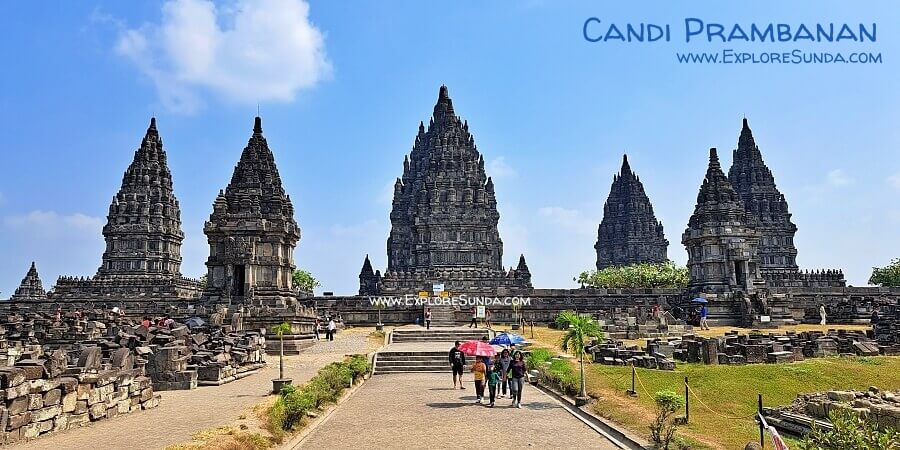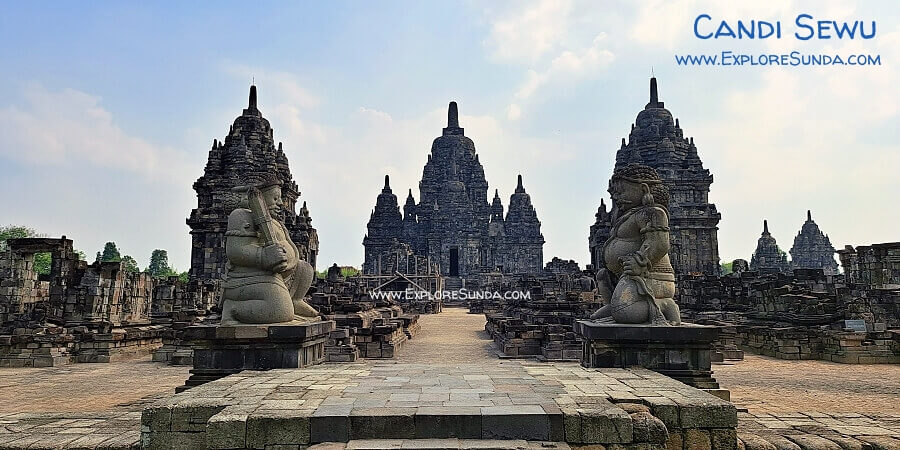The Legend of Roro Jonggrang
Roro Jonggrang, the beautiful princess from a long-forgotten kingdom in Central Java, lives on in legend — her story still whispers through the ancient temples of Java. Bound for eternity in cold stone, she was cursed to become the statue of the Hindu goddess Durga. The shivering chamber where she stood infinitely witnessed her fate. For centuries, this folktale has been shadowing the existence of Candi Sewu, Candi Prambanan, and Ratu Boko.
 The legend of Roro Jonggrang lives on eternity in Candi Prambanan.
The legend of Roro Jonggrang lives on eternity in Candi Prambanan.Who is Roro Jonggrang?
Once upon a time, there was a beautiful princess who lived in a grand palace of the Boko Kingdom. Her name was Roro Jonggrang, which means a slender maiden.
One day, the peace of the Boko Kingdom was shattered when Prabu Damar Moyo from the neighboring kingdom of Pengging declared war.
To secure victory, Prabu Damar Moyo sent his son, Bandung Bondowoso, to lead the attack. The young warrior was renowned for his extraordinary strength and mystical abilities. In a ferocious battle, Bandung Bondowoso slayed Prabu Boko. Defeated, the remaining army of Boko led by Patih Gupolo ran to the palace to protect Princess Roro Jonggrang – the daughter of Prabu Boko. After winning the battle, Bandung Bondowoso led his army to seize Ratu Boko — the palace of the Boko Kingdom. As he entered the palace to claim his victory, he caught sight of Princess Roro Jonggrang and was instantly captivated by her beauty.
Enthralled with the princess, Bandung Bondowoso immediately asked her hand in marriage. Yet the princess’s heart was filled with sorrow and anger. The way he killed her beloved father was still vivid in her memory. She wished to refuse him, but she knew she could not, for he held power over her kingdom. Therefore, she put two conditions to the proposal: Bandung Bondowoso had to dig a well called Jalatunda and build one thousand temples in one night.
Using his supernatural power, Bandung Bondowoso dug the Jalatunda Well with ease. When Roro Jonggrang came to inspect it, she cunningly persuaded him to descend into the well. As soon as he reached the bottom, Patih Gupolo and his men hurled massive stones into it, burying him alive.
Though buried beneath the stones, Bandung Bondowoso managed to escape from the well. He was furious, yet his obsession with Roro Jonggrang overrode his rage. In the end, he agreed to continue working on the second condition.
To build one thousand temples in one night, Bandung Bondowoso summoned spirits from the underworld to assist him. An eerie atmosphere covered the ground when they arose. Their speed was beyond human comprehension, and soon, the structures began to rise.
As the night wore on, the princess grew anxious, fearing they would complete the project well before the night was over. So, when they finished building 999 temples, Roro Jonggrang woke all her maids and villagers. She asked them to pound rice and set up a fire in the east to make it look like the sun had risen. It fooled the roosters, so they started to crow. Hearing the commotion and seeing the light in the east, all the spirits thought the day had begun. As a result, they immediately abandoned their work and returned to their world. Even Bandung Bondowoso could not stop them.
With only 999 temples completed, Roro Jonggrang had a reason to refuse the marriage proposal. But when Bandung Bondowoso discovered her deception, his fury knew no bounds. In his anger and heartbreak, he cursed her to become a statue — the final figure that would complete the thousandth temple.
 Candi Sewu, the temple compound built by Bandung Bondowoso in the legend of Roro Jonggrang.
Candi Sewu, the temple compound built by Bandung Bondowoso in the legend of Roro Jonggrang.Myth and History in Roro Jonggrang
Roro Jonggrang has lived on as a classic folktale since the sixteenth century era of the Mataram Sultanate, when people associated the sites of Ratu Boko Palace, Candi Prambanan, and Candi Sewu in the village of Prambanan.
The Abhayagiriwihara inscription records that Rakai Panangkaran, the Buddhist king from the Syailendra dynasty, built Ratu Boko around the eighth century. It reveals that the stone structures of Ratu Boko were a palace within a fortress. In the legend, however, this was Roro Jonggrang’s home, where she met Bandung Bondowoso, who besieged the palace.
Historical accounts identify Candi Sewu as a Buddhist temple compound, which was built by the same king around the same time as Ratu Boko. In the legend, it was said to be the thousand-temple complex built by Bandung Bondowoso to fulfill Roro Jonggrang’s impossible request. Although Sewu means “one thousand” in Javanese, in reality, the temple compound comprises only two hundred and forty-nine temples.
The story reaches its climax when Bandung Bondowoso, in anger and heartbreak, cursed Roro Jonggrang to become the statue that would complete the thousandth temple—the Durga statue in the north chamber of the Shiva temple at Candi Prambanan. It is here that myth and history diverge. Candi Prambanan is a Hindu temple, while Candi Sewu is Buddhist, and the two stand nearly eight hundred meters apart.
Yet across the centuries, their stories seem to converge—the tale of a cursed maiden and the grandeur of ancient faith carved into stone. To this day, Candi Prambanan is known as the Temple of Roro Jonggrang, the slender maiden who became legend.
Even so, whether born of devotion or imagination, her lingering presence through the legend of Roro Jonggrang continues to bridge the realms of history and belief. Centuries later, her story still lives in the Prambanan Temple Compound, which was listed in 1991 as one of UNESCO World Heritage Sites. Together with Sewu, Bubrah, and Lumbung Temples, it forms a captivating compound. Are you ready to explore Candi Prambanan Compound?
Recent Articles
-
Roro Jonggrang: A Tale Etched in the Stones of Prambanan Temple
Nov 05, 25 11:52 PM
Unravel the ancient Javanese legend of Roro Jonggrang that bridges myth, devotion, and the grandeur of Prambanan. -
Discover the Vibrant Celebration of Imlek in Indonesia!
Jan 13, 25 03:24 AM
The Chinese New Year of 2576 will be celebrated on January 29, 2025. Discover the special things in this Imlek festival! -
The Site Map of ExploreSunda.com
Nov 26, 24 10:40 PM
A thorough site map to help you browse through the Explore Sunda site.






